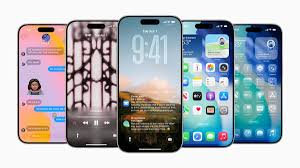Apple is set to make significant changes to the user interface of the iPhone with the release of iOS 26. The newest operating system from Apple introduces a revolutionary visual overhaul named Liquid Glass, characterized by translucent elements that give the impression of light warping and bending around app icons, buttons, and sliders. The aesthetic aims to unify the look and feel across Apple devices, ranging from the iPhone to the iPad and Mac.
While the new design has garnered mixed reactions, Apple has already made adjustments to address early concerns about readability, showcasing its responsiveness to user feedback. Alongside the fresh visual appearance, iOS 26 brings enhancements to key apps like Phone and Messages, as well as leveraging Apple's Visual Intelligence technology to offer advanced features such as real-time translations and visual search capabilities through screenshots.
One notable addition is the introduction of the Games app, acting as a central hub for gaming activities on iOS devices. This update is part of Apple's strategy to enhance user experience and drive engagement with its software ecosystem. Despite these improvements, the impact of software updates on iPhone sales remains a topic of speculation, with hardware upgrades historically being the primary driver for consumers.
Looking ahead, the development of iOS 26 sets the stage for Apple's possible entry into the market of superthin smartphones, with rumors suggesting the launch of an iPhone 17 Air later in the year. This move aligns with industry trends towards sleeker device designs and foldable technology, an area currently dominated by Android manufacturers like Samsung.
iOS 26 not only changes the visual appearance of iOS but also introduces practical features aimed at improving productivity. The revamped Camera and Photos apps offer a more streamlined user experience, with the ability to recognize specific contexts of photos, such as identifying images taken at concerts. Additionally, enhancements in call management, spam blocking, and multitasking functionalities enhance the overall usability of the operating system.
The iPad is not left behind in Apple's software advancements, receiving updates in iPadOS 26 to enhance multitasking capabilities. The new multitasking system, building on previous features like Split View and Slide Over, offers users a more flexible and versatile experience with window management. This change bridges the gap between the iPad and traditional desktop operating systems, making the iPad more suitable for users seeking productive multitasking features.
Apple has also introduced Continuous Background Tasks, enabling users to perform long-running operations in the background without affecting their primary tasks. These enhancements, coupled with refinements in audio and video recording functionalities, cater to users engaged in content creation activities, such as podcasting and video production, enhancing the iPad's utility for creative tasks.
However, despite these advancements, iPadOS 26 still faces limitations compared to macOS, particularly in terms of software restrictions and memory management. Users may experience performance discrepancies, especially on older devices with limited RAM, highlighting the trade-offs between portability and computing power inherent in tablet devices.
Ultimately, the software updates in iOS 26 and iPadOS 26 signify Apple's commitment to refining the user experience and providing innovative features to enhance productivity and creativity on their devices. These changes elevate the functionality of Apple devices and cater to a diverse range of user needs, positioning iOS and iPadOS as versatile platforms for work and entertainment.

